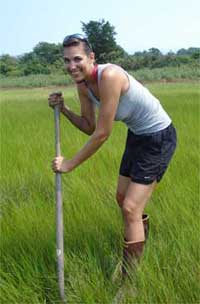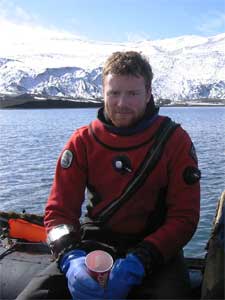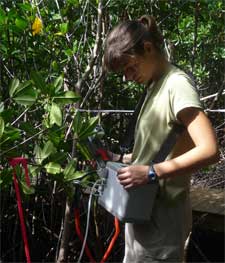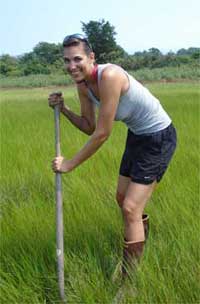The grants, two for $12,000 each and one for $4,000, have been awarded to student researchers who are examining nutrient pollution in salt marshes, quahog populations in Narragansett Bay, and the role of mangroves in the global carbon cycle. The winning students are Leanna Heffner of Santa Fe, N.M., Jeff Mercer of Lincoln, R.I., and Brita Jessen of Lexington, Mass.
“The Nature Conservancy is pleased to be able to tap into URI’s students and advisors who are working on cutting-edge ocean and coastal issues,” said Lynne Hale, director of the Conservancy’s Global Marine Initiative. “The work produced through our partnership with URI will inform and advance the Conservancy’s marine conservation efforts both locally and abroad.”
Heffner is studying how nitrogen is processed in three marshes in Narragansett Bay that experience varying degrees of nutrient pollution. This pollution, the result of agricultural activities, sewage outflow and lawn fertilizer runoff, fuels the growth of algae and leads to low oxygen conditions, decreases in biodiversity, and large fish kills.

“The sediment of the marshes can either act as a filter to remove nitrogen, or it can add more nitrogen to the system by converting nitrogen gas in the atmosphere into a fertilizer form,” Heffner explained. “”Many scientists have been trying to better understand these processes in marshes, and in Narragansett Bay the measurement of these processes has been limited. My research will employ a different set of techniques not yet used in local marshes.”
In his study of quahogs in Narragansett Bay, Mercer aims to develop a population model that incorporates the patchiness of dense quahog populations throughout the Bay. He said that, because of health concerns associated with the consumption of shellfish from polluted areas, dense populations of quahogs accumulate in areas closed to harvesting and may serve to resupply quahogs to harvested areas in the rest of the Bay.
“The big question my research hopes to address is what will be the outcome of harvesting the dense populations in polluted areas if the water quality improves,” Mercer said. “Will the Bay-wide quahog fishery collapse after the removal of these potential source populations, or are the closed areas not significantly contributing larvae and juveniles to the rest of the Bay?”
Mercer said that the results of his study may be useful in the development of a statewide shellfish management plan.
 Jessen’s study of mangroves in Jobos Bay, Puerto Rico, seeks to assess how much of the carbon-based material produced by the mangroves is retained within the mangrove forest and how much is exported off-shore.
Jessen’s study of mangroves in Jobos Bay, Puerto Rico, seeks to assess how much of the carbon-based material produced by the mangroves is retained within the mangrove forest and how much is exported off-shore.
“Mangrove forests are highly productive systems located on the edges of tropical shorelines,” she explained. “Using a stable isotope analysis, I can take sediment cores within the mangroves and extending out into seagrass beds to see how much of the sediment contribution is from the mangrove forest itself or brought in from off-shore.”
Jessen said that this information will help determine how resilient Caribbean mangroves are to rising sea levels and the role that they play in the global carbon cycle.
The Nature Conservancy is leading an international effort to conserve important ocean and coastal habitats for the benefit of marine life, ecosystems, local communities and economies. It works to restore degraded habitats and protect the best and most resilient examples of healthy habitats — from shellfish reefs, sea grasses and kelp beds to mangroves, fish spawning sites, coral reefs and estuaries. Through its Global Marine Team, TNC develops and promotes innovative strategies including marine protected area networks, community-based restoration and a range of market-based approaches.
Pictured above
Leanna Heffner
Jeff Mercer
Brita Jessen

